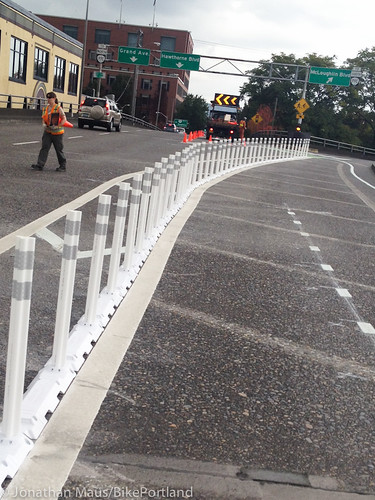
(Photos © J. Maus/BikePortland)
Just a quick note of follow-up to our post Tuesday about the newly expanded bike lanes on the Hawthorne Bridge: The County was out there today installing plastic “candlestick” bollards to help separate the bikeway from the adjacent lane.
I just rolled over and snapped a few photos…
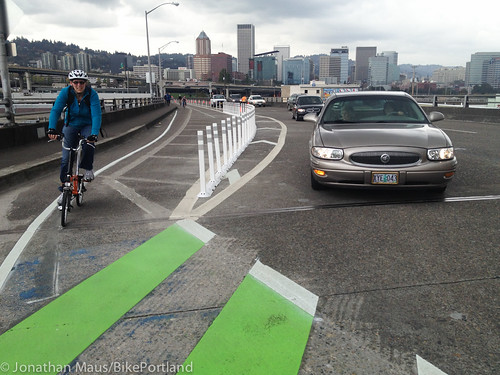
It’s great to see the that the County has replaced the old plastic bollards. Better yet, they’ve added many more and put them even closer together. In addition, this is the first time we’ve seen them use the interlocking plastic curb between the bollards. This seems like it will prevent the bollards from being uprooted by road users while at the same time create more physical separation and the resulting sense of safety that comes with it.
According to County spokesman Mike Pullen, the new type of candlestick bollards are called “curb-style lane delineators” and he says they’ll be more durable than the old kind. “They have a stronger attachment at their base,” he shared with us via email, “that helps them survive if a car drives over them.”
They would have done the entire 300 foot section with this new product, but only did about 150 feet of it due to budget reasons.
Hopefully the County shares this technology with the Portland Bureau of Transporation, who has quite the trouble getting these plastic bollards to stay put.


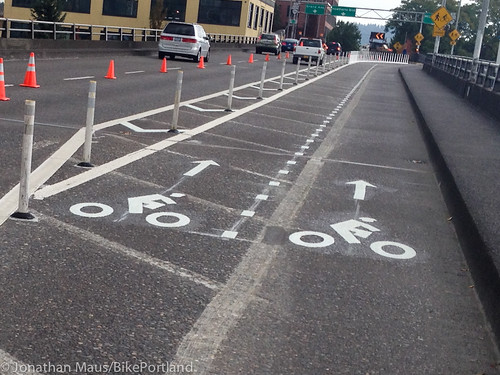
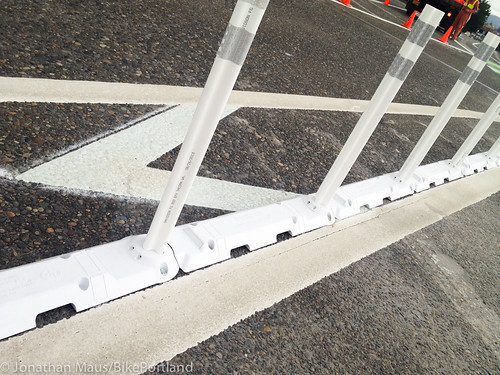

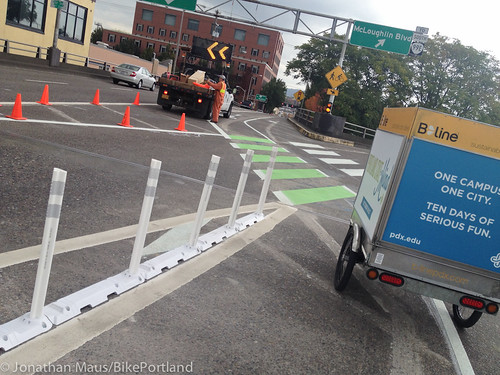
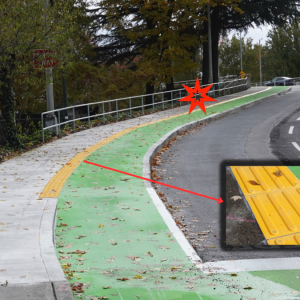
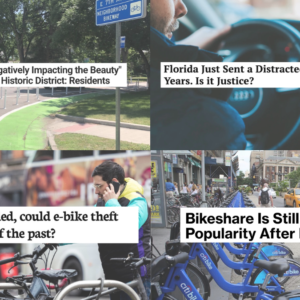

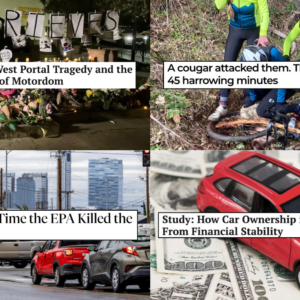
Thanks for reading.
BikePortland has served this community with independent community journalism since 2005. We rely on subscriptions from readers like you to survive. Your financial support is vital in keeping this valuable resource alive and well.
Please subscribe today to strengthen and expand our work.
Cool! It looks like that plastic curb is bolted into the roadbed, not just glued down, is that true?
Bolted or no, if Broadway’s Lovejoy viaduct is any test case, they still won’t last long.
Unlike on Lovejoy, here we have room for cement barricades. When the plastic gets run over…
I watched the county installing them, the plastic curb is bolted to the road.
Proactive! *Before* somebody gets hurt!
Are there any markings to designate who has the right of way?
A yield sign for the merging auto lane would be appropriate.
There is a large sign with a blinking light “Yield to Bikes” or something like that right near the split that is pretty easy to see. It’s pretty obvious and works *most* of the time.
they also added street markings to make a pedestrian zone, so Pedestrians aren’t walking on the silly one foot sidewalk. now pedestrians can walk in the road next to the bikes. You might notice teh two crosswalks there, one for bikes one for peds.
Walking in the road is a temporary condition – the county bridge division will be creating a wider sidewalk there, and the roadway “walkway” is temporary.
Awesome! This is at about the “Gold” level for bicycle infrastructure. Now, can they improve the bridge to street thresholds in/out of downtown?
Yeah, like the West end of the Hawthorne. How about a bike lane on Main Street? It gets so crowded and dangerous just a few blocks into town. . . a bike lane would carve out some space for riding.
They need to repave that section first. My god, the numerous large ruts and potholes on that street are a nightmare.
Why would you want to ‘create a more pronounced angle between users’???
I would much prefer to be able to merge left BEFORE the crosswalk, a maneuver which is now prevented by the curb and bollards.
What they really needed to do here, but didn’t, is to stop offering the motorists such a wide turning radius, which allows them to drive faster, rather than slower, where the bike lane crosses.
Just another reason I will continue to avoid this route completely.
I bike or walk this route nearly everyday, and must say that drivers for the most part are very aware. I’m glad that there is now a dedicated walkway, before it was kind of lame walking the small curb to get towards Grand.
Creating a more significant angle is good, however I do agree they did it backwards. The more significant angle should be implemented towards that lane of traffic in which does not have the right of way, the car lane in this case. Having the bollards closer together at the end here is creating a stronger visual barrier between the two vehicular lanes (bikes and car) and now pedestrian as well. This move could make it more hazardous since bicyclists and pedestrians will be “popping out” from the other side of the barrier now. The denser barrier should occur towards the beginning not the end so each side makes a better connection as the intersection approaches.
I appreciated the new lanes but some simple forward thinking will result in safer intersections and reduced cost or wasted man hours.
What would be sweet here are the yellow warning lights in which are placed in the roadway asphalt or concrete itself bordering the crosswalk but I haven’t ever seen these implemented in Portland probably due to the expense, we still just get crosswalks everywhere with no lights and no real (not media driven) enforcement.
Still bike this route everday and there is a close call I see probably 3/7 days (especially with those that are from out of state).
I agree that visually this might actually be a step backwards in terms of the safety (and false perception of safety) from both road and bike lane users. The bollards could be much shorter and still have the same effect, without creating a “fence” that the cyclists are riding behind. This is especially bad for recumbents or children, who may be lower than the fence. On the rider side, the protected lane may make people less aware of the hazard of cars approaching from the left, as it does seem to funnel riders cleanly across the gap. As mentioned, an even sharper approach angle for cars would really help here, and a combination of road-embedded lighting and a sensor (like the bike counter) that triggers it would really make a piece of quality infrastructure for this tricky intersection.
Not to put too fine a point on it, but if people would attend the county bike/ped committee meetings as members of the public, you can have the opportunity to learn about these changes in advance, and weigh in on them:
http://web.multco.us/transportation-planning/bicycle-and-pedestrian-citizen-advisory-committee
Two lanes in one direction for bikes! Is this the first place in town that that officially exists and is marked as such?
Madison Street west of Grand towards Hawthorne Bridge has had two bike lanes for a while.
I’d like to know how much these bollards cost, and the cost of installation as well.
probably about a million dollars. why dies it matter?
It needs to be payed for completely from the fuel tax as there would be no need for them if it weren’t for the unskilled and inattentive automobile drivers our state licenses every day as safe and legal.
Right wsbob? This wasn’t some attempt to imply that these bollards are a waste of money, right?
Because the argument that drivers need to wake up and pay the F attention is perfectly valid but does not exist in a vacuum.
We can push for driver education, safety and accountability while at the same time installing simple plastic to deal with the fact some people make mistakes.
typically, about $45/foot.
With only cursory knowledge of what OSHA compliant parking lot safety stuff costs at the corporate level I can only imagine that the FHWA & MUTCD compliant stuff costs more.
So $45/foot is probably cheap 🙁
I like it! Can’t wait to see this is person. Thanks to all who made this happen – it’s appreciated! 🙂
I love the bollards, yay Multnomah County!
I also noticed that the County removed the “yield to bikes” sign by the flashing light and replaced it with a more-common yellow “bikes and pedestrians here” sign. I worried if it would make the interaction between people biking and driving more fraught (who has the right of way? Wouldn’t be surprised if some/many people driving thought they did given that their lane continues uninterrupted while the bike lane zig-zags and becomes interrupted as it crosses the motor vehicle lane).
I would like to see a “State Law Yield to Bikes and Peds” neon sign here. But that’s probably just me. I would like to see them at every intersection of every block!
I prefer to merge left here way before the green zone.
So I see these bollards as pigeonholing us into a “supposed” safe crossing.
Which it is far from.
Once enough of them get destroyed it will be possible to merge left early and safely again.
Joy.
Why in the world did they block the additional passing lane with bollards at the beginning? Causing a passing cyclist to swerve pointlessly prior to entering the left lane makes no sense.
I’m also not a fan of the tight spacing of bollards. I was still able to take the lane but I suspect most cyclists will either start doing so earlier or waiting until they are past grand. It will be interesting to see how this works out.
Uh cause it is only bike one lane till after the bollards start. The bus lane is not technically a bike lane.
You can take the lane before the bollards start, if you’ve got the legs to ride at 25 mph up the grade . . .
Yesterday I took the buffer to the left of the bollards. This will give me more time to find a gap in traffic.
“Alex Reed” wrotea:
“I love the bollards, yay Multnomah County!. . .”
–but also:
“Wouldn’t be surprised if some/many people driving (cars) thought they (had right-of-way) given that their lane continues uninterrupted while the bike lane zig-zags and becomes interrupted as it crosses the motor vehicle lane. . .”
So much ‘bike infrastructure’ seems to be designed by car users, for car users, to manage bikes and keep them in a particular place instead of making the the streets safer and easier for bikes to use.
I haven’t seen the new candlesticks ftf, they look tougher but I still expect them to get shelled eventually. I’m amused every time I cross the Broadway Br. W-bound to see the continuing erosion of the _massive_ concrete barrier that separates cars and bikes wheres bikes stop for the light. I am pretty sure it’s not skaters grinding on that.
I ride this almost every day, the addition of the second lane seems unnecessary to me. Before it was there, the area was blocked off and you could easily pass slower cyclists if you so wanted to. Since the addition of the lanes I’ve noticed people try and go faster so as to not be passed (call it the Cat 6 effect).
The re-addition of the bollards is great, but I wished they went all the way down to the light (they didn’t last night) because I’ve seen several cars try and merge into the bike lanes.
Sinec the bollards are embedded in a thick plastic curb, I don’t think people will constantly run over them. Unless you are in a very large truck (semi/delivery), it will probably be quite noticeable it when your car lifts off the ground or bounces over the curb. Low profile cars could scrape the bottom on the curb itself…
If anyone hits this curb set at a good speed in a vehicle, they will likely jump the curb and have a helluva time getting back over. The spacing of the bollards is small, soooo it will be real fun to pull the car back over the curb while managing to not hit anymore bollards and later plucking the ones from under your car.
These curb sets are usually bolted into the ground, so they can withstand a lot more. See also: http://www.trafficlaneclosures.com/support/pdf_downloads/pexco_tacoma/IG_curb_system_Overview_2010%281%29.pdf
Came back from MMR last night over the Hawthorne (3 AM-ish) … like a birthday surprise at first….then realized how scarily exposed/hidden it felt. From the slight angle of the bridge decks’ rise, the line of a standard height auto driver’s sight will be obscured significantly. After looking over my shoulder and watching only the roof of a car go by and NOT being able to see the driver (*somehow disturbing and i don’t know why)….i merged back to the outside and rode the lane….not many cars after that, but there were no curbs to jump at that time…had they been there…yeah, i would’ve ate shit. This surprise infrastructure upgrade thing is cool and all, but the funnel and ‘pop out’ effect is going to be fatal at the crossing sooner or later. & no…i don’t want it to happen…it’s just the way these things block line of sight, making a driver unaware until the last second…making us harder to see keeps us ‘off their radar’ until it’s too late.
Looks good overall.
Hopefully the bollards won’t make it more dangerous for low-profile bicycles, like recumbents, to be seen by cars using the exit to MLK.
That’s a good point – considering how low my trike is. I may end up just taking the lane before them from now on – I typically run up that rise at 16-17mph. It’ll just have to be good enough I guess.
Also, regarding the Lovejoy Candles, I’m not convinced it was cars that took them out. I noted that when 53′ semis made the corner, it was physically impossible for them to make the turn without either crossing the double yellow line with the tractor or sweeping into the bike lane with the trailer. It’s only a 10′ driving lane, and those trucks are pretty close to 10′ on their own.
So certainly the ones at the top of the ramp were destroyed by trucks. It wouldn’t surprise me if trucks were largely responsible for the lower candles being gone, too.
PBOT engineers simply didn’t design the Lovejoy Viaduct lanes to be wide enough for truck traffic, and bike lane intrusion is a casualty of this decision.
If they were prioritizing movement and safety, rather than cramming in as many cars as possible at rush hour, the viaduct would only have one 12′ lane in each direction, wider at the two intersections, and a double bike lane going up the ramp in the center portion.
I haven’t experienced these lanes directly but im my time driving a 53′ trailer I can vouch for this.
When making a tight right turn the law (in Oregon at least) states that the going wide part of the turn must occur in the street I’m turning on to not the street I’m turning from. So from the rightmost lane I get as far to the left as i can be while still in the lane, pull forward in to the intersection as far as is needed to get my trailer tandems past obstructions and turn sharp right avoiding any cars queued up for a left turn.
The fun thing is that most urban intersections are designed and layed out with the absolute minimum amount of room required to make the turn without causing property damage.
Then they add bike lanes after the fact.
This is obvious by the fact that a lot of these urban right turns simply must be executed through the bike lane to avoid hitting cars on my left and light poles on my right.
Options: BAN trucks inside certain areas over a certain kingpin to tandem length like California does. Usually this is on twisty mountain switchbacks but in combination with weight restrictions and physically restricting height below 13’6″ you can effectively eliminate most big trucks.
OTOH : look at 6 years of YouTube videos of trucks crashing in to a well labled 11’8″ bridge Spectacular truck crash at 11foot8 bridge
Seems that now that the eastbound bike lane and eastbound exit ramp are on “separated roadways” there ought to be a stop sign, or a full yield sign for the exiting cars as they cross the bike ROW. As it is, its a bit of an uncontrolled intersection — even though bikes have the ROW, there are no signs from the standard family of “you don’t have the ROW anymore” signs for cars. Like a stop sign, a yield sign, or a red light.
Ted Buehler wrote:
“. . .If they were prioritizing movement and safety, rather than cramming in as many cars as possible at rush hour, the viaduct would only have one 12′ lane in each direction, wider at the two intersections, and a double bike lane going up the ramp in the center portion. . .”
The up hill bike lane on the right side serves most people reasonably well I think. It sets up the crossing to the E-bound sidewalk of the bridge. Guess you like a double center bike lane because of the trolley tracks which would be the most expensive thing to change there. Thing is: center bike lanes are unusual around here, and most likely to be disrespected by cars (seems to me).
The downhill bike lane–it lets W-bound bike riders keep rolling off the bridge, but then at the bottom of the hill they are supposed to make a right turn, do not pass go and definitely don’t turn left (a level 7 move because of the tracks, I don’t really suggest it for average bears with 25 cm tires).
This area (the Lovejoy ramp) could perhaps be improved for bike riders with some innovative signal design. A bike- and pedestrian-only signal at the top? Car drivers are more likely to observe and obey a signal light than a paint stripe. And whacking candlesticks–jolly fun.
This is an traffic exchange area that needs more input from the cycling public before an alteration this dramatic…me, personally… i prefer the option to be ‘in the lane’ BEFORE the merge off…because sometimes a proper hand signal informing auto users of my intent doesn’t count for squat. & more often than not, the ‘cars’ merging off don’t use signals…as if my ten plus years of cycle delivery work has only taught one invaluable lesson….don’t watch for blinkers….watch the front turning wheel of the nearest auto & always…ALWAYS, be prepared to stop or bail accordingly.
Poor original design for pedestrian usage forcing this ‘afterthought’ re-design. The ‘sidewalk’ after the merge point is useless for walkers (less than 18 inches wide), forcing peds that choose not to walk down and around Burger King back to Hawthorne to walk in the bike lane. The way it looks…the whole deal thing seems to want to force walkers that way (the long way). As if they were intent on creating simple access to McLoughlin for autos and the hell with other users. And now it needs to meet certain road use requirements…and still the citizens who use it most are left out of the decision process.
They’ve actually also taken away one of the car lanes heading down toward Grand and split the space between bikes and pedestrians now. Much more direct access to Grand. Still a poor initial design.
As a bike rider down in Oregon City and an auto driver who takes this turn at least once a week I’ve always been acutely aware of how easy it is to miss a seeing a bike rider here. Try to not take this turn unless my co-pilot/wife is along to spot the far back right. With the bollards it will be harder to see, I don’t even want to think about recumbent bikes. Don’t know the solution, except to encourage other auto drivers to do what I do, slow the ‘blankity blank’ way down and spend a second or even two or three to make sure some other human being gets past safely.
I’m not a fan – I used to negotiate across the lanes to the left lane starting quite a bit farther back than the end of the new bollards.
It’s no secret that planners at PBOT/metro view facilities that actively discourage merging, lane-taking, and speed as a feature not a bug. Apparently “transportation cycling” means cycling slooowly and being subjected to unnecessary risk at unsignalled intersections.
So keep on merging, “speed-racing”, and “lane-taking” sisters and brothers! Maybe some day Roger Geller will figure out that this is not Amsterdam…
I agree with most of the negative comments about this new crossing. The old crossing wasn’t great but at least you could signal and merge and make it more obvious to car drivers that you’re intending to go straight. The new bollards and curbing prevent this and what’s worse, they create a false illusion to car drivers that bikes will be exiting off to the right and not be crossing.
they should have put the bollards on the car side of the painted buffer instead of the bike side of the buffer.
Where possible, I like to get excited about infrastructure investment. But this looks like a place where motorized traffic has right of way. Unless the driver analyzes the direction of the paint by looking through the bollards, a reasonable person might well assume that the person on the bicycle will also take the right exit. And the exit is a nice radius to imply speed is appropriate.
Given the lack of understanding of the law regarding crosswalks and right-of-way where cyclists get waved through by motorists when they shouldn’t and pedestrians hang out at corners until clear… this looks to be highly problematic.
My approach will be to slow down as I approach and be ready to stop if driver is unaware. My actions as a result of this design will further reinforce that the motorist made no error unless I yell or otherwise gesture which is nearly always a bad plan.
I don’t know the definition of an intersection but this looks like an uncontrolled one to me.
Now there are TWO lanes that continue straight to the right of a automobile right turn.
The bollards are no big deal.
You can cross to the left before the bollards and ride in the lane or in the striped buffer strip . You can cross through the bollards nearly anywhere and go into the lane or the buffer. After crossing the exit lane there are no bollards so you can cross over at will.
The only thing you can’t do is cross over the bollards in the very last 30- ish feet before the bike path crosses the exit lane, that is where the plastic curbs are. At that point, drivers are busy looking for bikes headed for the green striped crossing, and it is not a good idea to confuse them by suddenly jinking left and popping into their lane.
And a good bike handler can hop the curb if he really wants to.
I do think a much more in-your-face “cars yield to bikes” flashing sign and pavement markings is warranted. I don’t know if there have been many accidents there.
“I don’t know if there have been many accidents there.” – there haven’t, but that’s not always the best driver (pardon the unintentional pun) for improvements.
The Multnomah County Bike/Ped Committee is always willing to listen to comments – if people have specific issues/problems with this implementation, take some time to show up for a meeting and comment publicly on it. The county can’t fix problems it’s not aware of.
I think the point is, they tried to fix something that was probably already as good as it was ever going to get without a major redesign, and now they’ve got an over-engineered mess out there.
“And a good bike handler can hop the curb if he really wants to.”
It’s a bike lane, not a cross course!
I rode this last night coming home from the Timbers match and was surprised by the bollards. I felt there was less visibility of the cars to my back left and my spidey sense kicked in that drivers may not assume my right of way. Whereas I used to look, signal, and move across the exit lane with confidence, last night I felt I had a 50/50 chance of a driver continuing through my right of way at speed.
The right-bearing curve of the bollards at the end also might give drivers the impression that bikes are being guided to the right, down the ramp and will not be crossing their path. The green striping is not really visible until right where bikes will be popping out (as others have said).
When I think of “bollards”, I think of great, honking, metal or concrete posts that will cause severe automobile damage, not these plastic toys.
This would have been the perfect chance for Portland to do their first NYC style epoxie gravel surfacing. NYC has quickly transformed areas into plazas, sidewalks, curb extensions using this material, and for cash poor PDX, it might be a perfect solution (photo: http://www.streetsblog.org/wp-content/uploads/2013/08/williamsbridge_oval_crosswalk.jpeg).
The new NACTO Urban Streets Design Guide goes into some details too: http://nacto.org/usdg/interim-design-strategies/moving-the-curb/
Both of these links were dead ends for me.
Here’s the photo:
http://www.streetsblog.org/wp-content/uploads/2013/08/williamsbridge_oval_crosswalk.jpeg
Today I watched the cyclist in front of me have to slam on his brakes and stop hard as a white truck barreled across this path without even slowing. If the cyclist hadn’t stopped there would have been a collusion. I wish they’d replace the “yield to cyclist” signs. I think if there had been a collision the truck driver could have (quite successfully) argued that he didn’t see the cyclist as the bollards were blocking his view and he wasn’t aware he was expected to yield.
I used to feel confident cycling this small stretch, but right now I find it very scary.
I like the improvements, but removing the “Yield to Cyclists” regulatory sign was unacceptable. Why remove the regulatory signs and leave the advisory signs in place, when it is in fact state LAW that cars must yield to bikes (and pedestrians) here?
Link to PBOT’s Bicycle Master Plan for 2030 “Best Practices” section (Appendix D), with design guidance for buffered bike lanes and bike passing lanes
http://www.portlandoregon.gov/transportation/article/334689 pages 2 of 41 and 3 of 41.